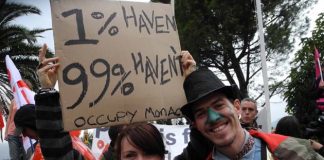THE BUSH Administration finally gathered support for a US$700 billion plan to bail out US banks—no less than US$2000 for every person in the United States. After one false start, the Congress followed the Senate in passing the bailout package.
This comes on top of US$29 billion to bail out Bear Stearns, US$200 billion to take over Fannie Mae and Freddie Mac and US$85 billion to take over insurance firm AIG.
Treasury Secretary Henry Paulson, former head of investment bank Goldman Sachs, spearheaded a pro-bailout campaign that united the Bush Administration, the Obama and McCain presidential campaigns and most of the media. Obama, the supposed candidate for change, played a crucial role in shoring up support for the bailout. Both Obama and McCain voted for the bill when it went before the Senate.
However Paulson faced tough opposition from other sections of the ruling class—particularly those Republicans and Democrats facing tight re-election battles in November. These members of Congress were acutely aware of mass public opposition to the bailout, particularly after receiving thousands of emails and phone calls from constituents, overwhelmingly opposing it.
As the ruling class in the US struggled to overcome their differences and cobble together a “solution” to the credit crisis it is clear that the ruling elite intend to make sure that it is the working class who absorb the cost of the crisis that they created.
The bailout plan
As the crisis spreads amongst firms in the US, the piecemeal bailouts have translated into a wholesale “plan” for dealing with the crisis.
Despite some meagre amendments, the US$700 billion plan is basically a handout to Wall Street. The government will buy up bad debts (bonds and securities that are tied to mortgages) from firms in trouble. The firms would then be able to resume their standard lending—and keep their profits. Furthermore, Paulson would effectively have sole control over the use of this US$700 billion (with any oversight in name only).
The Democrats secured several amendments, all of which are largely toothless. The bill now contains provisions for (easily avoidable) limits on CEO pay and for some attempts to recoup some of taxpayer money should the bailout prove successful.
The “sweeteners” came after the initial defeat of the bill in the House of Representatives, where 132 Republicans and 94 Democrats voted against it. Most of those who opposed the bill first time around were won over by the “bailout or bust” talk coming from Paulson and Bush or bought off by local spending targeted at their constituencies, something that was was written into the last version of the bill.
So what could be done?
Paulson and Bush led the pro-bailout charge by arguing that without it the crisis will spread from Wall Street to Main Street—hitting ordinary people.
But ordinary people are already the ones suffering from the crisis. They are the ones who have lost their homes, lost their jobs and faced empty pantries as food prices rise.
The bailout buys companies’ bad debts for taxpayers while profits stay in the private sector.
People are understandably very angry. The Bush administration has been unwilling to find any money for ordinary people over the last eight years. Social spending has been slashed to fund deeply unpopular wars in Iraq and Afghanistan. But now suddenly there is over US$700 billion to bail out the corporate CEOs that caused the current crisis in the first place.
The money could be used to help the masses of people who have already been affected by home foreclosures in the US and the growing number of people who will be affected as unemployment rises.
Banks could be truly nationalised—taking their profits as well as their losses. The Bush administration, and governments worldwide worried about the spreading crisis, could invest in infrastructure and public housing—creating jobs and giving people somewhere to live.
There have already been protests outside of Wall Street against the bailout plan. There is mass distrust of any “solution” being pushed by Bush, Paulson and their corporate cronies.
This distrust can be harnessed to push for solutions that would help the real victims of the credit crisis—the people losing their homes and jobs.
By Ernest Price




